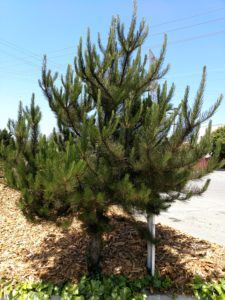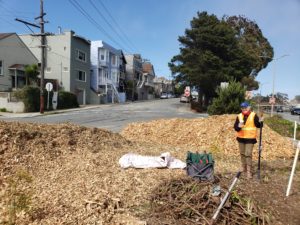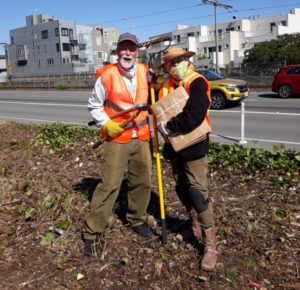Sometime in the middle of shelter-in-place the small triangle along San Jose Ave – where Arlington meets Wilder and Natick Street – began to transform. Shopping carts and tires became orderly piles. Great big mounds of cut fennel and diced ivy vines replaced the garbage. Our roadside eyesore started to have order and then mulch. Now it looks like a place where something is happening. Neighbors on Natick Street have started a movement. I asked Carol Hansen and Paul Muldown to share their story.
Carol: Well, neighbor Ed and I had been talking for years about planting something without really knowing what that meant. Neighbor Dan had planted a Monterey Pine years and years and years ago. But we we’re always ignoring that place because it was ugly.
Paul: And we were busy. Yes. With kids, life, work.
Carol: And then I thought, OK, this sounds like a long term community thing that I could be part of. Make something better right in the neighborhood.
Paul: And a good commute.
Carol: I feel like it’s gone in directions that I had, we had no idea. I mean, we are literally watching native plant videos every night. And that’s what I think is so much fun about it. We’ve got power to try to change something when everyone says you can’t do anything. So, after kind of feeling tied with the pandemic, it’s sort of like, wow, we can do this thing and who’s going to stop us?
Paul: I think, now, both of us are really comfortable out there because there’s so many people around: drivers, bikers, walkers, dog walkers, the whole thing. In the beginning, I think Carol was doing it alone and it was a little scary.
Carol: I’m looking out my window now and I can see cars going by on it. My goal is to have it screened. Nobody should have to look at San Jose Avenue and cars going by.
Paul: And we were busy. Yes. With kids, life, work.
Carol: And then I thought, OK, this sounds like a long term community thing that I could be part of. Make something better right in the neighborhood.
Paul: And a good commute.
Carol: I feel like it’s gone in directions that I had, we had no idea. I mean, we are literally watching native plant videos every night. And that’s what I think is so much fun about it. We’ve got power to try to change something when everyone says you can’t do anything. So, after kind of feeling tied with the pandemic, it’s sort of like, wow, we can do this thing and who’s going to stop us?
Paul: I think, now, both of us are really comfortable out there because there’s so many people around: drivers, bikers, walkers, dog walkers, the whole thing. In the beginning, I think Carol was doing it alone and it was a little scary.
Carol: I’m looking out my window now and I can see cars going by on it. My goal is to have it screened. Nobody should have to look at San Jose Avenue and cars going by.
Paul: We’re birders. And so my motivation now is getting natives in there so we can get the butterflies and the bees and the birds, the bugs. We heard a pygmy nuthatch up in one of the pine trees, that was kind of a surprise. And that’s about it. And I know it’s not because of the exposure to the cars and the wind and all that, because when we go over to the Excelsior Library and we walk across that overpass there are bushes right along 280 and we see cedar waxwings and these cars are whizzing by, you know, 80 miles an hour or whatever, and they don’t care. It would be so nice having some native trees and birds there. I think everybody in the neighborhood would like that.
Carol: It’s very interesting to me how people can ignore something right in their own backyard. So that’s what I’m noticing with our neighbors, people like that something better is going to happen. It’s going to be nicer. And I like being part of that.
Paul: And already where we work people are respecting it more. Not as much garbage dumping as there is down the hill.
Carol: Our neighbor across the street has three kids and she’s come out to give us a cup of coffee and power bars. And then she came out and the kids spent forty five minutes – they were just young energy, they wanted to help. Those guys were monsters out there.
Paul: I think that the socialization part of the project is a really good thing. There’s a chance of increasing people’s awareness about how they can take a part in beautifying the city or their neighborhood. So I think it really has that benefit.


Carol: It’s very interesting to me how people can ignore something right in their own backyard. So that’s what I’m noticing with our neighbors, people like that something better is going to happen. It’s going to be nicer. And I like being part of that.
Paul: And already where we work people are respecting it more. Not as much garbage dumping as there is down the hill.
Carol: Our neighbor across the street has three kids and she’s come out to give us a cup of coffee and power bars. And then she came out and the kids spent forty five minutes – they were just young energy, they wanted to help. Those guys were monsters out there.
Paul: I think that the socialization part of the project is a really good thing. There’s a chance of increasing people’s awareness about how they can take a part in beautifying the city or their neighborhood. So I think it really has that benefit.


